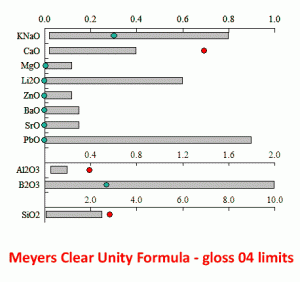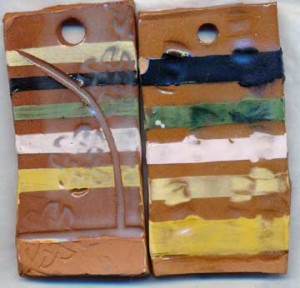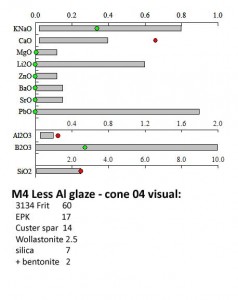Clean Creek Products is a company that markets materials reclaimed from coal mining. They’ve had a booth at NCECA to showcase their iron and manganese. There is a show coming up that features these materials, and I’ve been working with their iron and manganese to try to get something pretty in a glaze. On top of most non-lead majolica glazes, iron is just so very brown. Not amber-golden, not rich rust, but just brown. I rarely use brown in my majolica color palette, so I thought I’d take this as a nudge to do some fun slip work with paper stencils and look for glazes to go over that that are rust or golden.

UF has some clear glazes for 04 use – Deb’s Clear and (Ron) Meyers Clear. Both have issues. The Meyers Clear is the main one. If it gets thick, you get evil small craters that won’t heal, and just get worse if re-fired. I think it’s too viscous. The alumina is high, in addition to having boron. I’ve tested some similar formulas with lower alumina. The raw Meyers is also very high in frit. In addition to cost, high-frit glazes have to be applied unusually thinly for a good result – hard for beginners to judge.
The recipe for the Meyers Clear:
Frit 3124 89.8
EPK 10.2 plus 2 Bentonite.
When I look at the glaze under a 30x little microscope (Radio Shack has some that are cheap – $9.00 last I bought one), the glaze is filled with trapped bubbles. The up side is that it doesn’t run or even move, but it also in unforgiving about being too thick, and it’s very easy to get it that way.
My new version with less alumina and a bit more KNaO, and a test even less Al. Results were counterintuitive. The Less Alumina version of M4 has MORE bubbles that causes milkiness thick. Hmmm. Difference in clay color may be from different batches of test tiles. Using up old stuff. Slip colors very similar. Somehow, the bucket labeled WHITE SLIP is coming out pale yellow. Need to re-mix. Out of touch w/studio during the school year. Nice to get back to daily contact. M4 bleeds the black slip ever so slightly when thick. Maybe I can live w/that. I know just enough about glaze materials to know I don’t know enough. The M4 version looks better than the original Meyers Clear to me, but it will take testing on real thiings to see how it works.
Unity formula info from Glazchem:
Meyers Clear original
KNaO 0.302 Al2O3 0.392 SiO2 2.826
MgO 0.005 B2O3 0.541
CaO 0.693
Alumina:Silica ratio is 1.00:7.21 Neutral:Acid ratio is 1.00:3.03 Alk:Neut:Acid ratio is 1.00:0.93:2.83
Expansion: 74.8 x 10e-7 per degree C Oxides causing abnormal expansion: B2O3
Clear M4
KNaO 0.336 Al2O3 0.326 SiO2 2.786
CaO 0.658 B2O3 0.545
MgO 0.006
Alumina:Silica ratio is 1.00:8.55 Neutral:Acid ratio is 1.00:3.21 Alk:Neut:Acid ratio is 1.00:0.87:2.80
Expansion: 77.5 x 10e-7 per degree C Oxides causing abnormal expansion: B2O3
M4 Less Alumina
KNaO 0.337 Al2O3 0.247 SiO2 2.507
MgO 0.005 B2O3 0.544
CaO 0.658
Alumina:Silica ratio is 1.00:10.14 Neutral:Acid ratio is 1.00:3.18 Alk:Neut:Acid ratio is 1.00:0.79:2.51
Expansion: 80.5 x 10e-7 per degree C Oxides causing abnormal expansion: B2O3



Hey Linda, I use a version of Rons glaze that is 80-3124, 10, silica, 10 epk. It has problems when to thick and gets very cloudy, just like most fritted glazes. We have been adding 1 percent iron to it, which gives the glaze a little bit of an amber tinge when to thick but when thin is nice and clear. Thanks for sharing this great info!
-Nate